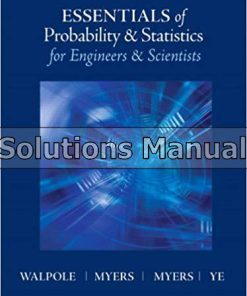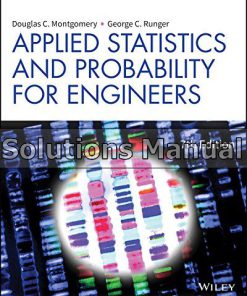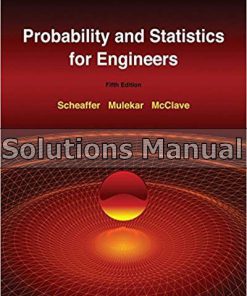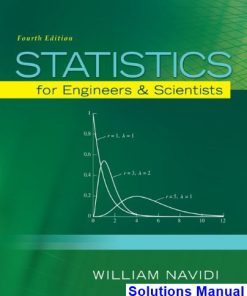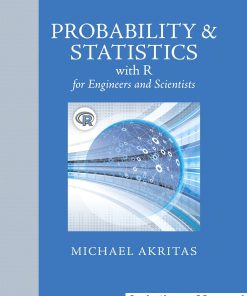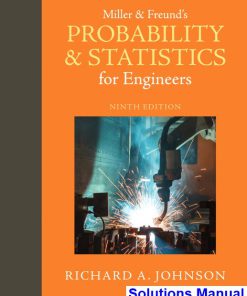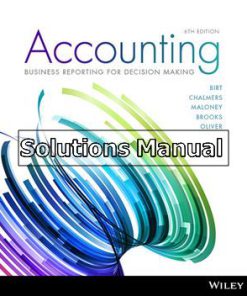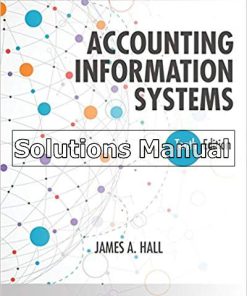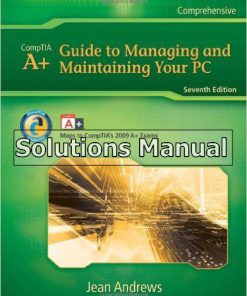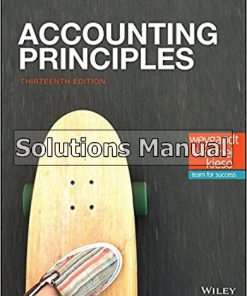Introduction to Probability and Statistics for Engineers and Scientists 5th Edition Ross Solutions Manual
$26.50$50.00 (-47%)
Introduction to Probability and Statistics for Engineers and Scientists 5th Edition Ross Solutions Manual.
You may also like
Instant download Introduction to Probability and Statistics for Engineers and Scientists 5th Edition Ross Solutions Manual pdf docx epub after payment.
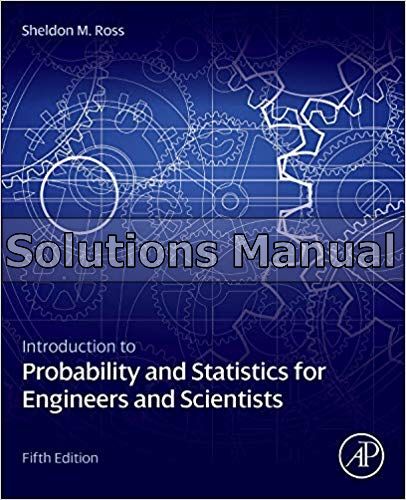
Product details:
- ISBN-10 : 0123948118
- ISBN-13 : 978-0123948113
- Author: Sheldon M. Ross (Author)
Introduction to Probability and Statistics for Engineers and Scientists, Fifth Edition is a proven text reference that provides a superior introduction to applied probability and statistics for engineering or science majors. The book lays emphasis in the manner in which probability yields insight into statistical problems, ultimately resulting in an intuitive understanding of the statistical procedures most often used by practicing engineers and scientists.
Real data from actual studies across life science, engineering, computing and business are incorporated in a wide variety of exercises and examples throughout the text. These examples and exercises are combined with updated problem sets and applications to connect probability theory to everyday statistical problems and situations. The book also contains end of chapter review material that highlights key ideas as well as the risks associated with practical application of the material. Furthermore, there are new additions to proofs in the estimation section as well as new coverage of Pareto and lognormal distributions, prediction intervals, use of dummy variables in multiple regression models, and testing equality of multiple population distributions.
This text is intended for upper level undergraduate and graduate students taking a course in probability and statistics for science or engineering, and for scientists, engineers, and other professionals seeking a reference of foundational content and application to these fields.
Table of contents:
- Dedication
- Preface
- Organization and Coverage
- Supplemental Materials
- Acknowledgments
- Chapter 1. Introduction to Statistics
- 1.1 Introduction
- 1.2 Data Collection and Descriptive Statistics
- 1.3 Inferential Statistics and Probability Models
- 1.4 Populations and Samples
- 1.5 A Brief History of Statistics
- Problems
- Chapter 2. Descriptive Statistics
- 2.1 Introduction
- 2.2 Describing Data Sets
- 2.3 Summarizing Data Sets
- 2.4 Chebyshev’s Inequality
- 2.5 Normal Data Sets
- 2.6 Paired Data Sets and the Sample Correlation Coefficient
- Problems
- Chapter 3. Elements of Probability
- 3.1 Introduction
- 3.2 Sample Space and Events
- 3.3 Venn Diagrams and the Algebra of Events
- 3.4 Axioms of Probability
- 3.5 Sample Spaces Having Equally Likely Outcomes
- 3.6 Conditional Probability
- 3.7 Bayes’ Formula
- 3.8 Independent Events
- Problems
- Chapter 4. Random Variables and Expectation
- 4.1 Random Variables
- 4.2 Types of Random Variables
- 4.3 Jointly Distributed Random Variables
- 4.4 Expectation
- 4.5 Properties of the Expected Value
- 4.6 Variance
- 4.7 Covariance and Variance of Sums of Random Variables
- 4.8 Moment Generating Functions
- 4.9 Chebyshev’s Inequality and the Weak Law of Large Numbers
- Problems
- Chapter 5. Special Random Variables
- 5.1 The Bernoulli and Binomial Random Variables
- 5.2 The Poisson Random Variable
- 5.3 The Hypergeometric Random Variable
- 5.4 The Uniform Random Variable
- 5.5 Normal Random Variables
- 5.6 Exponential Random Variables
- 5.7 The Gamma Distribution
- 5.8 Distributions Arising from the Normal
- 5.9 The Logistics Distribution
- Problems
- Chapter 6. Distributions of Sampling Statistics
- 6.1 Introduction
- 6.2 The Sample Mean
- 6.3 The Central Limit Theorem
- 6.4 The Sample Variance
- 6.5 Sampling Distributions from a Normal Population
- 6.6 Sampling from a Finite Population
- Problems
- Chapter 7. Parameter Estimation
- 7.1 Introduction
- 7.2 Maximum Likelihood Estimators
- 7.3 Interval Estimates
- 7.4 Estimating the Difference in Means of Two Normal Populations
- 7.5 Approximate Confidence Interval for the Mean of a Bernoulli Random Variable
- 7.6 Confidence Interval of the Mean of the Exponential Distribution
- 7.7 Evaluating a Point Estimator
- 7.8 The Bayes Estimator
- Problems
- Chapter 8. Hypothesis Testing
- 8.1 Introduction
- 8.2 Significance Levels
- 8.3 Tests Concerning the Mean of a Normal Population
- 8.4 Testing The Equality of Means of Two Normal Populations
- 8.5 Hypothesis Tests Concerning the Variance of a Normal Population
- 8.6 Hypothesis Tests in Bernoulli Populations
- 8.7 Tests Concerning the Mean of a Poisson Distribution
- Problems
- Chapter 9. Regression
- 9.1 Introduction
- 9.2 Least Squares Estimators of the Regression Parameters
- 9.3 Distribution of the Estimators
- 9.4 Statistical Inferences about the Regression Parameters
- 9.5 The Coefficient of Determination and the Sample Correlation Coefficient
- 9.6 Analysis of Residuals: Assessing the Model
- 9.7 Transforming to Linearity
- 9.8 Weighted Least Squares
- 9.9 Polynomial Regression
- 9.10 Multiple Linear Regression
- 9.11 Logistic Regression Models for Binary Output Data
- Problems
- Chapter 10. Analysis of Variance
- 10.1 Introduction
- 10.2 An Overview
- 10.3 One-Way Analysis of Variance
- 10.4 Two-Factor Analysis of Variance: Introduction and Parameter Estimation
- 10.5 Two-Factor Analysis of Variance: Testing Hypotheses
- 10.6 Two-Way Analysis of Variance with Interaction
- Problems
- Chapter 11. Goodness of Fit Tests and Categorical Data Analysis
- 11.1 Introduction
- 11.2 Goodness of Fit Tests When All Parameters are Specified
- 11.3 Goodness of Fit Tests When Some Parameters are Unspecified
- 11.4 Tests of Independence in Contingency Tables
- 11.5 Tests of Independence in Contingency Tables Having Fixed Marginal Totals
- 11.6 The Kolmogorov–Smirnov Goodness of Fit Test for Continuous Data
- Problems
- Chapter 12. Nonparametric Hypothesis Tests
- 12.1 Introduction
- 12.2 The Sign Test
- 12.3 The Signed Rank Test
- 12.4 The Two-Sample Problem
- 12.5 The Runs Test for Randomness
- Problems
- Chapter 13. Quality Control
- 13.1 Introduction
- 13.2 Control Charts for Average Values: The X¯ Control Chart
- 13.3 S-Control Charts
- 13.4 Control Charts for the Fraction Defective
- 13.5 Control Charts for Number of Defects
- 13.6 Other Control Charts for Detecting Changes in the Population Mean
- Problems
- Chapter 14. Life Testing
- 14.1 Introduction
- 14.2 Hazard Rate Functions
- 14.3 The Exponential Distribution In Life Testing
- 14.4 A Two-Sample Problem
- 14.5 The Weibull Distribution in Life Testing
- Problems
- Chapter 15. Simulation, Bootstrap Statistical Methods, and Permutation Tests
- 15.1 Introduction
- 15.2 Random Numbers
- 15.3 The Bootstrap Method
- 15.4 Permutation Tests
- 15.4.1 Normal Approximations in Permutation Tests
- 15.5 Generating Discrete Random Variables
- 15.6 Generating Continuous Random Variables
- 15.7 Determining the Number of Simulation Runs in a Monte Carlo Study
- Problems
- Appendix of Tables
- Index
People also search:
Introduction to Probability and Statistics for Engineers and Scientists 5th Edition
Introduction to Probability and Statistics for Engineers and Scientists 5th Edition pdf
Introduction to Probability and Statistics for Engineers and Scientists
introductory probability and statistical applications
introductory probability and statistical applications meyer
what is introduction to probability and statistics

